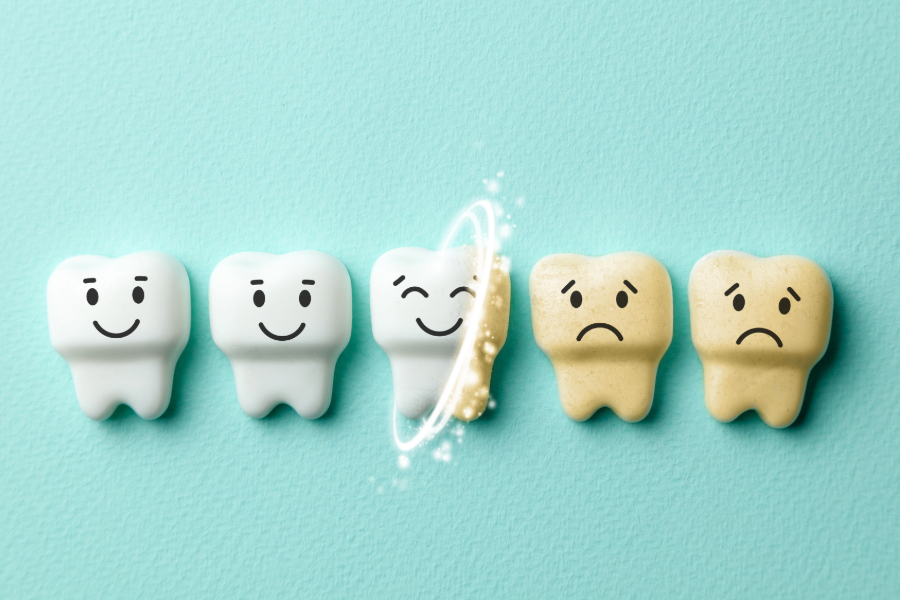What to know before whitening your teeth
Posted on June 5, 2025 in Healthy You

Who doesn’t want a whiter smile? Teeth whitening is popular — just walk down your local drugstore dental aisle and you’ll see dozens of products promising a gleaming white smile. But what products are best for you? Are over-the-counter products even worth it?
It can be overwhelming to know which route to take when it comes to achieving whiter teeth. Here, we offer a 5-step teeth whitening roadmap to help make the process easier.
Step 1: Consult a dentist (not the internet)
The internet is a treasure trove of information, but when it comes to your oral health, your dentist should be your most trusted source. Avoid do-it-yourself whitening concoctions that you find online. Even if the recipes boast natural ingredients, they can still harm your mouth. For example, one online trend encouraged people to mix mouthwash, hydrogen peroxide and baking soda and apply the paste to their teeth for a whiter smile. But that combination of ingredients can severely damage your enamel and gums.
A dentist can also help you understand if you are a candidate for whitening products, so you don’t end up wasting your time and money. Teeth whitening works best on superficial tooth stains, such as those caused by dark drinks or aging. Deeper stains caused by injury or medication won’t respond as well to teeth whitening treatments. And teeth whitening products also aren’t effective on dental restorations like crowns, fillings and veneers.
Step 2: Discuss whether professional treatments are worth it
If you want the most powerful and effective whitening treatments available, talk to your dentist about the options they have in their office. Professional whitening treatments use stronger whitening agents that last longer than over-the-counter products used at home. Another benefit of professional whitening is that your dentist will tailor the treatment to your specific needs and dental health history. However, these treatments are more costly than at-home whitening products, and most dental plans do not cover whitening.
Even if you don’t want to pursue your dentist’s professional whitening options, discussing teeth whitening with your dentist is still helpful because they can provide recommendations on quality at-home whitening products that are effective and budget-friendly.
Step 3: Understanding at-home whitening products
Over-the-counter products like whitening strips, LED kits and whitening toothpaste are relatively inexpensive and contain natural whiteners like hydrogen or carbamide peroxide. These treatments can deliver results when used correctly, but they are still less effective than professional whitening.
Let’s take a closer look at whitening toothpastes. Not all whitening toothpastes are created equal, so it’s important to understand the differences when weighing your options.
The best option: Fluoride toothpastes with a whitening agent are safe and effective.
The best to avoid: Charcoal toothpastes are harsh on your teeth and can wear down your enamel and irritate your gums.
The best at scamming: Purple toothpaste claims to whiten, but it only delivers the illusion of whiter teeth, as the purple color neutralizes yellow tones on teeth. These toothpastes don’t actually whiten teeth.
Step 4: Be prepared for side effects
Like any treatment, both professional and over-the-counter teeth whitening products have side effects that you may experience. Side effects are usually mild and short-lived, and the most common are tooth sensitivity and gum irritation. These usually go away within a few days. Using a desensitizing toothpaste before and after whitening will help minimize any pain, but call your dentist if your side effects aren’t going away or are severe.
Step 5: Maintaining dazzling results
If you’ve achieved a beautiful white smile, keep it bright by avoiding darker foods and drinks. Of course, eliminating them from your diet isn’t realistic, so simply rinsing with water after you consume them will help keep your teeth whiter for longer. Good at-home oral hygiene like twice daily brushing and daily flossing will also keep stains away. And, of course, seeing your dentist twice a year will ensure that your smile stays healthy from the inside out.